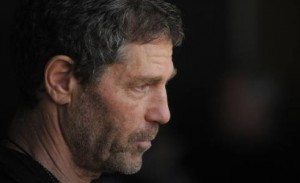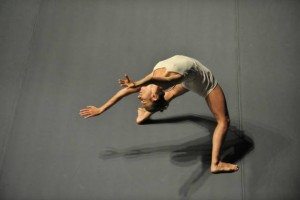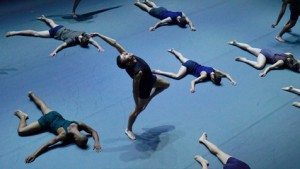
What is Gaga? Well, it can be difficult to explain. As adults, we tend to be too concerned with correctness, bogged down with the pressures of the world, overcome with insecurity, and puppeteered by our own habits to really understand the entire scope of possibilities around us. It's easy to outgrow our childhood inhibitions and lose touch with our souls -- our source for creativity. We tend to stop listening.
Gaga is a physical language that facilitates reconnection, healing, self-discovery, individual expression, and the channeling of energy. The movement was founded by Ohad Naharin, Israeli dancer, choreographer, and Artistic Director of the Batsheva Dance Company in Tel Aviv. He is currently in New York for the release of Mr. Gaga, a stunning documentary about his love for life and dance.
Sitting alone in a room with Mr. Naharin was one of the most exciting, nerve-racking, and terrifying moments of my life thus far. I sat down and slowly unfolded a piece of paper, hands shaking uncontrollably. Out of embarrassment, I abandoned my efforts to completely unfold the paper and placed my palms flat on the table to hide this nervous movement. How ironic, I thought, that I would hide this from someone who has dedicated so much of his life to opening people up.
So much of Gaga is process rather than product. What inspires you to go through and beyond the process and communicate something to a larger group of people?
I think it has to do with the thing that turns me on. I'm lucky to be able to invest a huge part of my life in those things. Those things have to do with the love of dance, the love of composition, the love of sharing what I find, and also the ability to find the things I never imagined existed by working with a brilliant group of people.
 What I really find interesting, something that came up a few times in the documentary, is the concept of doing little but feeling a lot; not trying to do too much for fear might get in the way of how you're feeling or sensing something. Is that something you find is a difficult concept for the people you’re working with to understand?
What I really find interesting, something that came up a few times in the documentary, is the concept of doing little but feeling a lot; not trying to do too much for fear might get in the way of how you're feeling or sensing something. Is that something you find is a difficult concept for the people you’re working with to understand?
The idea of doing less is just one thing. Sometimes it's a lot about doing more with less. Sometimes it is about exaggeration and sometimes it is about turning the volume very high. I like when the people I work with develop skills that [involve] the ability to turn the volume on under how they listen to the scope of sensations. Many times it is about sensing a lot and we don't need to move because it can help the interpretation and the quality of their movement later. Let me give an example: you can listen to hard metal music [that is] very distorted. You can turn down the volume to where you can barely hear it and it's still hard metal music. The idea of turning the volume down, it forces you to open up how you listen. So this is something that we use — playing with volume at both [extremes] in order to [strongly sense] something.
Dance is a lot about small gestures, [which] actually helps you create balance in your body because if you just go for big gestures or big muscles, you can create blockages and you can actually create atrophy with the small groups of muscles in your body. It's something to do with the healing aspect of movement, the efficiency aspect of movement, the animalistic way of moving, the flow of information, explosive power, speed… all these things come from this kind of listening.
These qualitative aspects are accessible to all people, not just dancers. Can you tell me a little bit about your experience working with people who are “non-dancers,” if there is such a thing?
What's considered a non-dancer for me is someone who does not have the ambition to be onstage. It does not mean [they] cannot dance, because to dance does not mean to perform. Also, for my dancers, the act of dancing [comes] before thinking about performance. [Dance] is about your connection to the universe. It is something we can share with people who have no ambition to be on stage. We can research things like finding out where our blockages are; finding out how we can bring more flow; finding out how we can use the force of gravity, which is the most important force in life and in dance, and how we can utilize it to become more efficient. I think I have learned more from meeting non-dancers [than] I have learned from meeting my dancers. So I invest a lot in that research: what is really common for all of us as people, whether you're sitting in a wheelchair, or have Parkinson's disease, or a handicap, or [have had] a stroke or an accident… or we are all Olympic gold medalists. We're still sharing a lot more then we are different.
There's a beautiful moment in the documentary where you say, "Often in auditions you don't see what's locked inside people. My challenge is to discover those locked people, because eventually you can open them up and enjoy that treasure." Although you were referring to auditions, I think it's a wonderful way of talking about how you work with people in general. How do you open people up and what do you see in individuals that informs you in this?
A lot of what I've developed in Gaga is like a set of keys. If you have a treasure, I can just give you the key to open it up. [Often] times this one key can feed many people. Everybody has treasures. Some people have huge treasures; some people have not so big treasures. Everybody still has those treasures so everybody can open up something.
Ballet dancers, for example, work with mirrors. Just the cancellation of a mirror is already a key to start listening to the scope of sensations (instead of looking for what's correct) and finding the efficiency of your form and the clarity of your form… not through a mirror, not through looking at yourself, but through sensing. A lot of ballet [dancers] look for form without feeling that flow of information in the body and without listening to the force of gravity... It's not about how much you weigh; it is about gravity. It's a force that you can feel not just from the outside of your body. The difference between listening to how much you weigh and how much gravity is used is like listening to how gravity slices through you, because the inside of you is also obeying the force of gravity, not just your outside. When you start really listening to gravity on a molecular level and you give people the license to feel it, they discover a lot about healing, about efficiency, about pleasure. This also can evoke the flow of emotions... and when [people] start [opening up], they can go through a lot of self-discovery about themselves and later they can create transformation of their emotions into a very clear form and very free form. Or they can [transform] anxieties or anger into explosive power, the ability to let go, and things like that.
 You use imagery a lot when working with people trying to get them to access something specific that they're maybe not accessing already. Do you find that you have a big store of images that you draw from or are you continually finding new images?
You use imagery a lot when working with people trying to get them to access something specific that they're maybe not accessing already. Do you find that you have a big store of images that you draw from or are you continually finding new images?
It's both actually because many times when I connect to a person I work with, it can bring up something I didn't think about before. The thing about Gaga is that it is a process. Gaga is not just a toolbox I draw from but it is a box I add to with this research. It's both.
The images are very fundamental for someone to get rid of habits. One of the most important things is that we become aware of our habits and acquire new ones.
How long does that take? They say it takes 30 days to break a habit. But I imagine that's not necessarily true in this case.
They think it takes 30 days to break a habit? I wonder, why 30 days? Who said that? Don't listen to them. (Laughs)
That's why I'm bringing it up…
It depends on what you mean because breaking habits can take a lifetime because you need to work on it all the time. I think it's first recognition of your habit. It can be one minute if you can make a dancer aware that they're blocking something in the shoulder blades or in the chest, or that they use their left side more than the right side... Let's say you ask a dancer to move fast and he moves fast, but actually he can move a lot faster. [He may] realize: I'm still measuring myself instead of trying to go beyond.
It takes time to develop the muscles that we make you change and that can be an ongoing thing that takes months or years, but it can also be a very fast, immediate thing. As soon as a dancer feels a new sensation and that dancer goes beyond what is familiar, he is already changing his habit. So the 30 days is…
It's interesting think about what it really takes, especially (to use your example) for a ballet dancer that has perhaps studied ballet since they were a kid.
It could be a long process. Long is also relative… what is long? But if you're talking about muscle structure and muscle mass, it comes from changing movement habits and it comes from the way you listen to your body. This can be immediate; this can also be endless because you can always find more.
In the documentary, we see an evolution of communication. You go from just wanting the dancers to read your mind to later when you say that the act of choreographing is helping your dancers interpret the movement. Can you tell me about how your mindset has changed over the years and how you take on this role as choreographer who facilitates interpretation?
I think it has to do with that I was very unhappy, that I didn't have a toolbox. I didn't have the means to create a positive dialogue with someone I work with. Because I didn't have [the means] I was frustrated. Because I was frustrated I could get upset or I could get even hurtful to the people I work with. But once (slowly) I developed the tools to see the solution -- instead of just see the problem but have no solution -- as a way to help create this solution for what was the problem, then I was much more calm and much more communicative… much less conflicting and much more about this dialogue. That took many years actually, a long time. And I'm still working on it. This is part of the development of Gaga.
When do you follow dancers’ interpretation and when do you pull that interpretation back to your core vision?
The idea of the control that I want to have comes from a little bit of the control freak that I am. But if I'm aware that I'm a control freak, I can laugh at it. This is just part of who I am in front of the people I work with. At first I want to give them a safety net; I want to give them a sense of trust, a sense that we are licensed to fail, a sense that what I ask them is not going to hurt them and that we are on the journey to discover something we don't know exists, but a journey that will take us to that place where we will find something new. I can still be very demanding, but the dancers feel that it's for reason. I learned to direct, to be a director. To be a choreographer you cannot abuse your power. You need to use the power of convincing. To convince is what you need to do because if someone you're working with is convinced [that] what you tell them is good for them, then they will do it happily and be with you.
 I've heard you mention that there's not necessarily an answer as to what made you start dancing, why you dance, or what keeps you dancing. Do you seek out these answers or do you enjoy not knowing?
I've heard you mention that there's not necessarily an answer as to what made you start dancing, why you dance, or what keeps you dancing. Do you seek out these answers or do you enjoy not knowing?
It's not the lack of knowing; it's the lack of proof. Because there's a lot of things we know, like I know that there is no god... but I cannot prove it. I know that there is life out of space, but I cannot prove it. But I know it. Maybe you agree with me.
Once you know something but you also feel privileged you don't have the proof… I really feel that I don't have to prove what I know. And it helps me to just keep going with the love of it or the knowing of it. It can help me to make decisions, [to help] how I educate my daughter, to tell me how I communicate with my dancers. Eventually they will know what I know even though we didn't prove it.
That's interesting. So many people want to identify reasons for why they do what they do… I'm not sure I'm interested in that.
But it's connected to moments (not in my work but in other people’s works) that are sublime… that you really feel it's worthwhile to be there. It gives you the knowing and you still might not know how to articulate it or verbalize it, but you know that you witnessed [that which] makes it worthwhile: that you witnessed something that creates codes that push something that is out of the box, that it's not obeying the already existing rules of culture but it writes the new rules. For myself, I don't necessarily know how to to do it… but I witnessed it. You know what I mean?
Yes, I think I do.
(Smiling) Good.